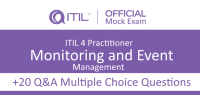In the past 12 to 18 months, digital transformation meant that many organisations moved from a “marketplace” to a “marketspace”.
For example, in the training industry, a lot of providers had to shift their training courses online. Figures from PeopleCert in Poland showed that in 2019 – before the Covid-19 pandemic – 97% of exams were paper-based whereas, in 2020, 70% of exams were taken online.
While traditional training courses are based on physical proximity with customers (i.e. face-to-face in a classroom), transferring to a virtual world benefits benefits them by removing borders. However, many have underestimated the risks involved.
Much of the transformation focus here has been on the delivery aspect. What has been missing is exploring the earlier part of the customer journey, i.e. marketing in a digital business environment and acquiring customers through online channels only.
Applying ITIL 4 best practice to a transformed business model
A key lesson from the past year is that bringing customers from a marketplace to a marketspace is a big challenge. You have to both think and act virtually.
Therefore, organisations have had to access the type of guidance in ITIL 4 Specialist: Drive Stakeholder Value, specifically about marketing segmentation to distinguish between a physical and virtual marketplace. This includes creating personas for customers and typical service consumers.
Knowing this has been important to service management and service managers: when you design services and come to market, you need to know what the interactions with customers and users of the services will look like. For example, taking an exam online is very different from a paper-based exam. So, this needs a rethink of customer interaction when promoting and delivering services.
This has enabled organisations to adapt service for the best customer experience and to see service delivery from the customer’s point of view.
Looking into 2022: skills, capabilities and ITIL 4
What will be essential in 2022, based on the experience of 2020-21, is speed to market in the virtual world.
Therefore, people will need better decision-making skills and less hierarchy to make changes based on customer and user feedback. Slow decision making may mean the provider is too late to the party.
Also, taking a lead from DevOps, organisations should focus on products; with autonomous product teams and individual product owners making decisions. However, to avoid the risk of creating silos with no real collaboration, this also needs an effective method for sharing information and lessons learned between teams – in other words, a kind of knowledge management.
By understanding one of ITIL 4’s four dimensions of service management – information and technology – you can establish where to share knowledge and the support tools to enable that.
A new breed of technology user
Since the onset of the pandemic the technical maturity among IT users is now at a whole new level.
This is good news when encouraging acceptance and adoption of new technology in organisations. There’s no point having sophisticated digital services without mature users. Now the users are more ready for this sophistication – and are more engaged with the feedback loop – you can really see value co-creation in action.
For organisations, this means delivering new services, obtaining user feedback, and then filling the gaps.
But it’s also about choosing the right methods to support organisational strategy: rather than choosing just one approach because it’s fashionable (such as DevOps, for example), you need a broad set of practices to deliver services and customer satisfaction effectively.
Source: https://www.axelos.com/resource-hub | Author David Billouz – CEO, Ociris








